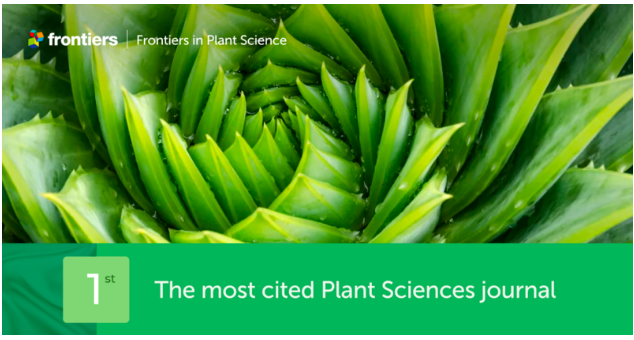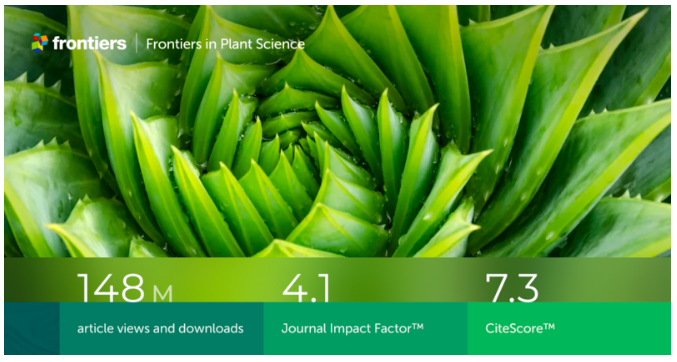
Frontiers in Plant Science 是一本由科学家主导的开放获取期刊,备受全球植物科学领域研究者的支持与肯定。期刊最新影响因子为 4.1,CitesScore 为 7.3。期刊目前拥有 24 个专栏,涵盖了从作物分子遗传学、细胞生物学和生理学到生态学、进化生物学和植物病原学等各个领域,利用计算机科学、光学、分子生物学、生物化学和基因组学等的最新发展,来探讨植物细胞、个体、种群、到生态系统过程及其背后机制。

我们整理了近期发表在 Frontiers in Plant Science 的文章,综合其影响力,评选出具有代表性的文章共 24 篇,以飨读者。本文为第二篇(第一篇可看),将推荐选读其中的 6 篇研究,为方便深入了解,每篇均附精要导读,以下为导读原文:

Supplemental greenhouse lighting increased the water use efficiency, crop growth, and cutting production in Cannabis sativa
文章导读
The expanding cannabis production sector faces economic challenges, intensified by freshwater scarcity in the main US production areas.
Greenhouse cultivation harnesses sunlight to reduce production costs, yet the impact of greenhouse light levels on crucial production components, such as plant growth, branching, and water use efficiency (WUE), remains poorly understood. This study aimed to assess the effects of combined sunlight and supplemental lighting on the crop’s main production components and leaf gas exchange of Cannabis sativa ‘Suver Haze’ in the vegetative stage. Within a greenhouse, LED lighting provided at intensities of ~150, 300, 500, and 700 µmol m*(-2) s*(-1) (18-hour photoperiod), combined with solar radiation, resulted in average daily light integrals of 17.9, 29.8, 39.5, and 51.8 mol m*(-2) d*(-1). Increasing light levels linearly increased biomass, leaf area, and the number of branches per plant and square meter, with respective rates of 0.26 g, 32.5 cm*2, and 0.41 branches per mole of additional light. As anticipated, crop evapotranspiration increased by 1.8-fold with the increase in light intensity yet crop WUE improved by 1.6-fold when comparing the lowest and highest light treatments. Moreover, water requirements per unit of plant biomass decreased from 0.37 to 0.24 liters per gram when lighting increased from ~18 to 52 mol m*(-2) d*(-1), marking a 35% reduction in evapotranspiration.
These results were supported by increments in leaf photosynthesis and WUE with light enhancement. Furthermore, our findings indicate that even 52 mol m*(-2) d*(-1) of supplemental lighting did not saturate any of the crop responses to light and can be economically viable for cannabis nurseries. In conclusion, light supplementation strongly enhanced photosynthesis and plant growth while increasing WUE. Additionally, a comprehensive discussion highlights the shared physiological mechanisms governing WUE in diverse plant species and their potential for water conservation under enhanced lighting conditions.
原文链接👇
https://www.frontiersin.org/journals/plant-science/articles/10.3389/fpls.2024.1371702/full?
utm_source=kexuewang&utm_medium=cpm&utm_content=2502&utm_campaign=webpromochn

对塞尔维亚老葡萄园中的葡萄树进行基因鉴定,揭示巴尔干地区传统品种之间的多种关系
文章导读
Serbia preserves a high number of local grape varieties, which have been cultivated across the country for centuries. Now, these ancient varieties are in the spotlight, and there is a global trend towards their recovery and characterization because they can revitalize regional, national and international grape and wine sectors.
In addition, their genetic study can be useful to find new pedigree relationships to reveal how local varietal assortment evolved over time. Here, the genetic characterization of 138 grapevines from old Serbian vineyards revealed 59 different genetic profiles, 49 of which were identified as grapevine varieties whose origin in the country could be linked to some major Serbian historical periods. Most of the genetic profiles found in this work arranged in a complex pedigree network that integrates numerous grapevine varieties from diverse Balkan countries, agreeing with an intense exchange of plant material among Balkan regions for centuries.
This analysis identified some varieties as important founders of Balkan genetic resources, like ‘Alba Imputotato’, ‘Braghina Rosie’, ‘Coarna Alba’, and ‘Vulpea’. After deepening into their genealogy, these major direct founders might have ultimately derived from ‘Visparola’, an ancient variety of likely Balkan origin with a major founding role in some European regions. Our results also indicated the genetic singularity of the grapevine resources from the Balkans when compared to those from other relevant winemaking regions, supporting the interest of their detailed study to evaluate their oenological potential and for the eventual identification of useful traits to counteract current viticulture challenges.
原文链接👇
https://www.frontiersin.org/journals/plant-science/articles/10.3389/fpls.2024.1391679/full?
utm_source=kexuewang&utm_medium=cpm&utm_content=2503&utm_campaign=webpromochn

优化柑橘植物体内基因组编辑和转化的方法
Optimization of in planta methodology for genome editing and transformation in Citrus
文章导读
Genetic transformation of many plant species relies on in vitro tissue culture-based approaches. This can be a labor-intensive process, requiring aseptic conditions and regenerating often recalcitrant species from tissue culture. Here, we have optimized an in planta transformation protocol to rapidly transform commercial citrus cultivars, bypassing the need for tissue culture.
As a proof of concept, we used in planta transformation to introduce CRISPR/Cas9 constructs into Limoneira 8A Lisbon lemon and Pineapple sweet orange, cultivars that are challenging to transform with conventional techniques. Using our optimized protocol, the regeneration rate was significantly increased from 4.8% to over 95%, resulting in multiple gene-edited lines in lemon. We also successfully recovered gene-edited Pineapple sweet orange lines using this protocol; the transformation efficiency for these cultivars ranged between 0.63% and 4.17%.
Remarkably, these lines were obtained within three months, making this in planta protocol a rapid methodology to obtain transformed citrus plants. This approach can rapidly and effectively introduce key genetic changes into a wide variety of citrus cultivars.
原文链接
https://www.frontiersin.org/journals/plant-science/articles/10.3389/
fpls.2024.1438031/full?utm_source=kexuewang&utm_medium=cpm&utm_content=2504&utm_campaign=webpromochn

紫外光和适应性分化的叶片生理,生理结构和超微结构驱动基因遗传差异较大的葡萄藤品种对高温压力产生耐受性
文章导读
The genetic basis of plant response to light and heat stresses had been unveiled, and different molecular mechanisms of leaf cell homeostasis to keep high physiological performances were recognized in grapevine varieties. However, the ability to develop heat stress tolerance strategies must be further elucidated since the morpho-anatomical and physiological traits involved may vary with genotype × environment combination, stress intensity, and duration.
A 3-year experiment was conducted on potted plants of Sardinian red grapevine cultivars Cannonau (syn. Grenache) and Carignano (syn. Carignan), exposed to prolonged heat stress inside a UV-blocking greenhouse, either submitted to low daily UV-B doses of 4.63 kJ m*(-2) d*(-1) (+UV) or to 0 kJ m*(-2) d*(-1) (−UV), and compared to a control (C) exposed to solar radiation (4.05 kJ m*(-2) d*(-1) average UV-B dose). Irrigation was supplied to avoid water stress, and canopy light and thermal microclimate were monitored continuously. Heat stress exceeded one-third of the duration inside the greenhouse and 6% in C.
In vivo spectroscopy, including leaf reflectance and fluorescence, allowed for characterizing different patterns of leaf traits and metabolites involved in oxidative stress protection. Cannonau showed lower stomatal conductance under C (200 mmol m*(-2) s*(-1)) but more than twice the values inside the greenhouse (400 to 900 mmol m*(-2) s*(-1)), where water use efficiency was reduced similarly in both varieties. Under severe heat stress and −UV, Cannonau showed a sharper decrease in primary photochemical activity and higher leaf pigment reflectance indexes and leaf mass area. UV-B increased the leaf pigments, especially in Carignano, and different leaf cell regulatory traits to prevent oxidative damage were observed in leaf cross-sections. Heat stress induced chloroplast swelling, plastoglobule diffusion, and the accumulation of secretion deposits in both varieties, aggravated in Cannonau −UV by cell vacuolation, membrane dilation, and diffused leaf blade spot swelling.
Conversely, in Carignano UV-B, cell wall barriers and calcium oxalate crystals proliferated in mesophyll cells. These responses suggest an adaptive divergence among cultivars to prolonged heat stress and UV-B light. Further research on grapevine biodiversity, heat, and UV-B light interactions may give new insights on the extent of stress tolerance to improve viticulture adaptive strategies in climate change hotspots.
原文链接
https://www.frontiersin.org/journals/plant-science/articles/10.3389/
fpls.2024.1399840/full?utm_source=kexuewang&utm_medium=cpm&utm_content=2505&utm_campaign=webpromochn

综述性研究——钙缺乏是否是真正导致苦痘病的原因?
Is calcium deficiency the real cause of bitter pit? A review
文章导读
Bitter pit is a disorder affecting the appearance of apples. Susceptibility is genetically controlled by both the cultivar and rootstock, with both environmental and horticultural factors affecting its severity and proportional incidence. Symptoms appear more frequently at the calyx end of the fruit and consist of circular necrotic spots, which take on a “corky” appearance visible through the peel. Bitter pit may develop before harvest, or after harvest, reducing the proportions of marketable fruit.
In this review, current knowledge of the factors associated with the occurrence of bitter pit in apples is summarized and discussed along with their interactions with Ca uptake and distribution to fruit. This disorder has been previously linked with localized Ca deficiencies in fruit during its development. However, these relationships are not always clear. Even with over a century of research, the precise mechanisms involved in its development are still not fully understood.
Additional factors also contribute to bitter pit development, like imbalances of mineral nutrients, low concentration of auxins, high concentration of gibberellins, changes in xylem functionality, or physiological responses to abiotic stress. Bitter pit remains a complex disorder with multiple factors contributing to its development including changes at whole plant and cellular scales. Apple growers must carefully navigate these complex interactions between genetics, environment, and management decisions to minimize bitter pit in susceptible cultivars.
Accordingly, management of plant nutrition, fruit crop load, and tree vigor still stands as the most important contribution to reducing bitter pit development. Even so, there will be situations where the occurrence of bitter pit will be inevitable due to cultivar and/or abiotic stress conditions.
原文链接
https://www.frontiersin.org/journals/plant-science/articles/10.3389/fpls.2024.1383645/full?
utm_source=kexuewang&utm_medium=cpm&utm_content=2506&utm_campaign=webpromochn

前沿专刊述评:快速育种技术在作物改良和功能基因组学研究中的应用
Editorial on the Research Topic:
Applications of fast breeding technologies in crop improvement and functional genomics study
文章导读
New crop varieties are increasingly crucial to agriculture production, and their development depends on the exploration and application of key germplasm resources, often referred to as seed chips. Conventional breeding strategies are time-consuming, but recent advances in fast breeding technologies have significantly accelerated the process of crop trait modification, gene mapping, and functional genomics studies.
These technologies include molecular selection, molecular mapping of genes, haploid induction, and genome editing mediated by CRISPR/Cas9. CRISPR/Cas9 has been applied to rapidly modify important crop traits such as disease resistance, quality, maturity, grain weight, sterility, and pre-harvest sprouting tolerance. Particularly, new haploid inducer lines have been created in maize, rice, Arabidopsis, wheat, alfalfa, foxtail millet, tomato, Brassica oleracea, and soybean by editing MTL (PLA1/NLD), DMP, and PLD3 genes via CRISPR/Cas9 to produce haploid grains directly. Additionally, new types of molecular markers have been developed and used to trace agronomically important traits in breeding programs and locate target genes on chromosomes for gene cloning alongside generally employed makers such as simple sequence repeat (SSR), single-nucleotide polymorphism (SNP), and expressed sequence tags (EST).
Using these techniques, the period for breeding new crop varieties and germplasms can be greatly shortened. Therefore, we organized this Research Topic to collectively report the achievements in the applications of fast breeding technologies in genetic improvement and functional genomic studies in various plants. Since the initiation of this Research Topic in June 2023, we have received 39 manuscripts on the development, application, and summarization of fast breeding technologies in plants. Finally, 15 papers have been published in this Research Topic after careful evaluation.
原文链接
https://www.frontiersin.org/journals/plant-science/articles/10.3389/fpls.2024.1460642/full?
utm_source=kexuewang&utm_medium=cpm&utm_content=2507&utm_campaign=webpromochn

Frontiers in Plant Science 是瑞士出版社 Frontiers 旗下的开放获取期刊,目前位于 JCR 植物科学分区 Q1,中国科学院分区生物学 2 区 top,植物科学 2 区。期刊最新影响因子为 4.1,CitesScore 为 7.3。期刊目前拥有 24 个专栏,涵盖了从作物分子遗传学、细胞生物学和生理学到生态学、进化生物学和植物病原学等各个领域,利用计算机科学、光学、分子生物学、生物化学和基因组学等的最新发展,来探讨植物细胞、个体、种群、到生态系统过程及其背后机制。

Frontiers 总部位于瑞士,是全球领先的开放获取(Open Access)出版商,致力于使科学在全球范围内更加开放,其发布的研究文章已被浏览和下载超过 28 亿次。欲了解更多详情,欢迎访问 Frontiers 官方网站:www.frontiersin.org.
转载本文请联系原作者获取授权,同时请注明本文来自Frontiers开放获取科学网博客。
链接地址:https://wap.sciencenet.cn/blog-3465500-1468925.html?mobile=1
收藏

